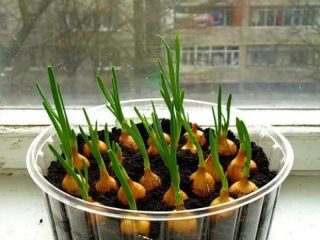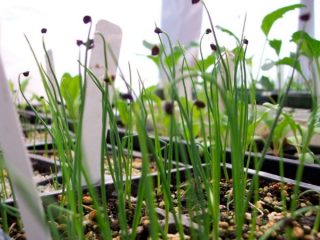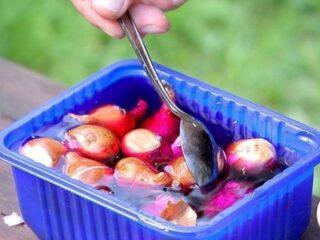Content
Onion Sturon (Sturon) is among the first most popular crop varieties. Gardeners often prefer it because of its excellent taste, high yield and unpretentiousness. In addition, the variety has increased resistance to severe frosts and diseases, perfect for long-term storage.
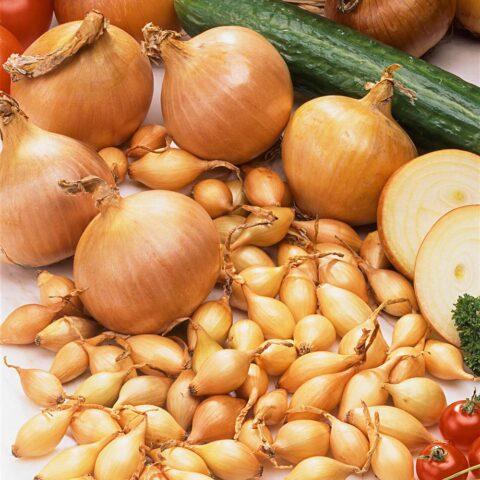
Onion Sturon has an excellent presentation, ideal for sale
Origin story
The Sturon onion was bred by Dutch breeders and immediately after its appearance on the European market, it has proven itself well. In 2009, the variety was entered into the State Register of Russia. The variety is recommended for cultivation in the Central region, as well as in the West Siberian regions, and is recognized as one of the most productive for the conditions of the Russian Federation.
Description and characteristics of Sturon onions
Onion Sturon belongs to the medium-late universal varieties, the type is spicy. Juicy turnips and a green feather are used for food. The hybrid is endowed with pronounced breeding characteristics, good rooting, strong vigor. The weight of one onion of the Sturon variety is about 100-150 g, with regular fertilization, the mass can reach 200 g. Onions have a spicy-sweet piquant taste with a classic aroma, are a source of minerals and vitamins.
Appearance
Variety Sturon forms a rounded, elongated head at one end, covered with 4-5 thick light brown scales. The inside is juicy, the flesh is white, it can have a greenish tint. The leaves are tubular, gray-green in color, grow up to 0.5 m in height. As it grows, inflated flower arrows form on the feathers of the Sturon onion, which can rise up to 1.5 m above the ground. When fully expanded, the inflorescence of the culture forms a snow-white ball. The capsule contains 5-6 small black seeds.

Arrows with inflorescences of the Sturon variety are sometimes left to get nigella
Ripening time and yield
The Sturon onion reaches technical ripeness after 100-130 days from the day of germination. With timely planting, favorable weather and climatic conditions, up to 35 kg of crops are harvested from a garden bed 1x0.5 m and up to 250 kg from one hundred square meters. Immediately after harvesting, the ripeness of the variety is 75%, at the end of ripening - 100%.
The high yield and excellent keeping quality of Sturon onions have been proven in practice by thousands of gardeners. Timely collected and well-dried heads retain their useful properties and excellent taste for 6-8 months.
Disease and pest resistance
When the development of varietal traits of the plant was carried out, one of the dominant abilities was identified by the specialists as the resistance of the variety to diseases and pests. Therefore, the rate of resistance of the Sturon bow to various misfortunes is quite high. But, despite the strong immunity, with poor care of the crop, it can be susceptible to mosaic, neck rot, downy mildew.Among insects, Sturon's enemies are the nematode and the lurking beetle, in rare cases the onion fly.
To avoid troubles associated with diseases or insects, preventive crop treatments should be organized in a timely manner and the rules of crop rotation should be observed.
Composition and properties
The Sturon variety has a high sugar content due to which its taste is quite spicy. According to the test results, it has been proven that this onion contains many nutrients (iron, calcium, potassium) and vitamins (A, D, C, E, group B). Not only the bulb itself is useful, but also the feathers. 100 g of vegetable contains 17.3 g of sugar, 14.6 g of dry matter and 7.5 mg of ascorbic acid.
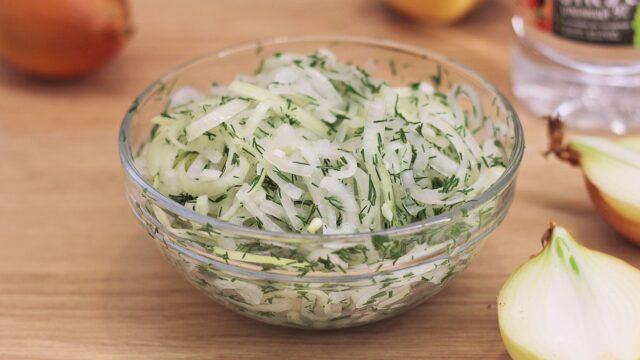
Dishes to which onions are added not only taste special, but are also healthy.
Where is used
All-purpose Sturon onion. Suitable for all types of processing and fresh consumption. The variety is widely used in cooking, added to homemade preparations. It is ideal as an addition to meat, fish, salad dishes. The elongated shape of the head is practical to use, it is convenient to clean and cut.
Advantages and disadvantages
Sturon onions, like any other crop variety, have their pros and cons. It is worth taking them into account even before planting a plant.
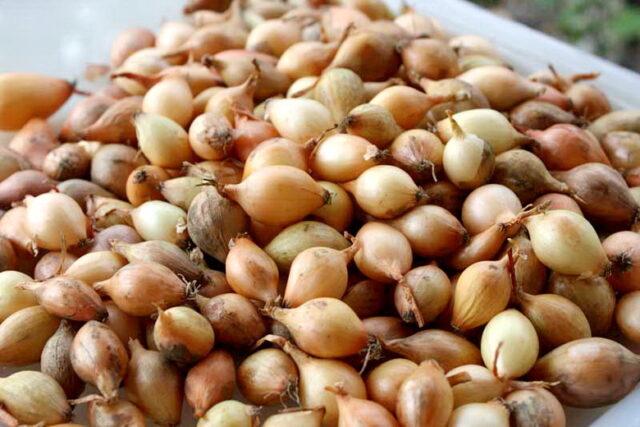
If you use a large set for growing, then the mass of mature onion heads will be greater.
Benefits:
- long shelf life;
- high productivity;
- large sizes;
- cold resistance;
- excellent taste characteristics;
- convenience in cutting.
Disadvantages:
- exactingness to the composition of the soil;
- vulnerability to mosaic and powdery mildew.
Planting methods Sturon onions
Usually, Sturon onion is grown as a two-year crop, that is, caring for it is divided into two annual cycles. The first implies sowing seeds for sowing, and the second - planting small turnips, which grow over the summer to full-fledged bulbs. Each stage provides for its own characteristics of agricultural technology, which must be taken into account.
Growing from seeds
Onion sets of the Sturon variety are grown from nigella. Sowing is usually carried out in late March, early April, but the specific planting time depends on the climatic zone of the culture. Perform it according to the following scheme:
- The planting material is soaked for two hours.
- The plot is dug up, the beds are prepared, grooves are made in them up to 5 cm deep with an interval of 10 cm.
- Water the wells with warm water.
- After the water leaves the ground, seeds are sown (about 90 pcs per 1 sq. M.).
- They are covered with earth, slightly compacted.
- Slightly sprouted shoots are thinned out, leaving a distance of 2-3 cm between them.
Sevok is harvested closer to August.
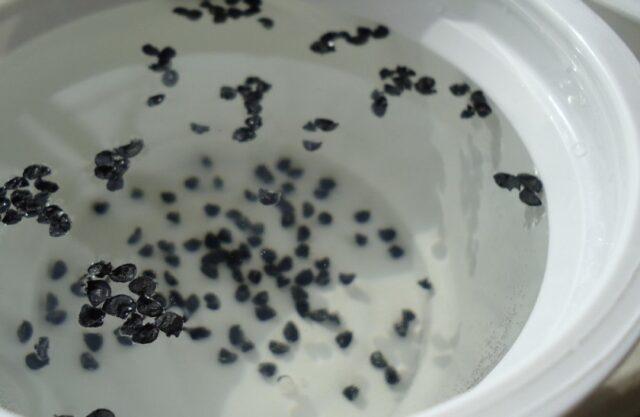
Growing independently and maintaining Sturon varieties until spring is not easy
Planting seedlings in the spring in open ground
To get a full crop harvest, Sturon sevok can be planted in the spring. The procedure is performed in a prepared, organic-rich fertile soil with a slightly alkaline reaction. Sandy loam and loam are better suited for this. The plot is dug up a couple of weeks before planting, a bucket of humus and azofoska (30 g per sq.m.) are introduced into the soil. If necessary, add dolomite flour, ash or lime. Despite the fact that the Sturon onion is a healthy variety, the planting material is processed before sowing. Put the turnips in a bag, sprinkle them with Karbofos, leave for 24 hours. After that, the onion sets are kept for 30 minutes in a solution of potassium permanganate. Depending on the place of cultivation, Sturon is planted in late April, early May in well-heated soil. The place is chosen open, illuminated, with a low humidity indicator. First, grooves are formed on the bed with a depth of 5 cm at a distance of 20 cm from each other. Wood ash or sand is poured into the bottom of the grooves. The sevok is planted with the bottom down to a depth of 3 cm every 15 cm.Then the planting is covered with fertile soil and slightly compacted.
Planting Sturon onions before winter
Some gardeners plant Sturon onions before winter. This is especially practiced by residents of northern latitudes. Planting is carried out towards the end of September or at the beginning of October according to a scheme identical to spring sowing, with the exception of soaking the seedlings and pruning. Turnips for a full harvest are taken with dry husks and the smallest ones, and for greens - undergrown or overgrown specimens. Of the winter varieties, Sturon onions are considered the most popular.

In regions with a cool climate, it is advisable to cover the seedlings with spunbond after sowing.
Sturon onion care
Hybrid onion Sturon is unpretentious. In order to get large heads, plantings need to perform elementary agrotechnical work.
The culture needs watering mainly at the initial stage of growth and during the period of turnip formation. Half a month before harvesting the onion is stopped moistening.
Loosening of the beds should be carried out 3-4 times a month. The first time the procedure is performed when shoots appear, then as needed. When flower arrows grow, they are immediately removed, the same is done with weeds.
Fertilize Sturon onions with mineral and organic compounds. When the green mass is actively growing, nitrogen is introduced into the soil (saltpeter, diluted manure or chicken droppings), after a month they are watered with complex fertilizers with microelements, 30 days before harvesting, they are fed with phosphorus-potassium preparations.
When the feathers of the Sturon onion turn yellow and fall, it is time for the harvest. The heads are removed from the ground using a pitchfork, shaken off the rest of the soil, and kept for several hours in the sun to dry. Then the onions are tied in bunches and hung or laid out in one layer in a dry, well-ventilated area. After the tops are dry, they are cut off, leaving a two-centimeter column, the excess scales are removed, the roots of the plant are carefully cut off and the crop is sent for storage. Sturon lies well at a temperature of + 2-4 ° С, humidity 80% or at +20 ° С, humidity 60%.
Conclusion
Sturon onion is an excellent vegetable variety suitable for growing in all regions of Russia. Both summer residents and large farms are engaged in planting it. Judging by numerous reviews, the plant has excellent taste and excellent keeping quality, it is easy to grow. Sturon retains useful qualities for a long time, can be used for cooking any dishes.



